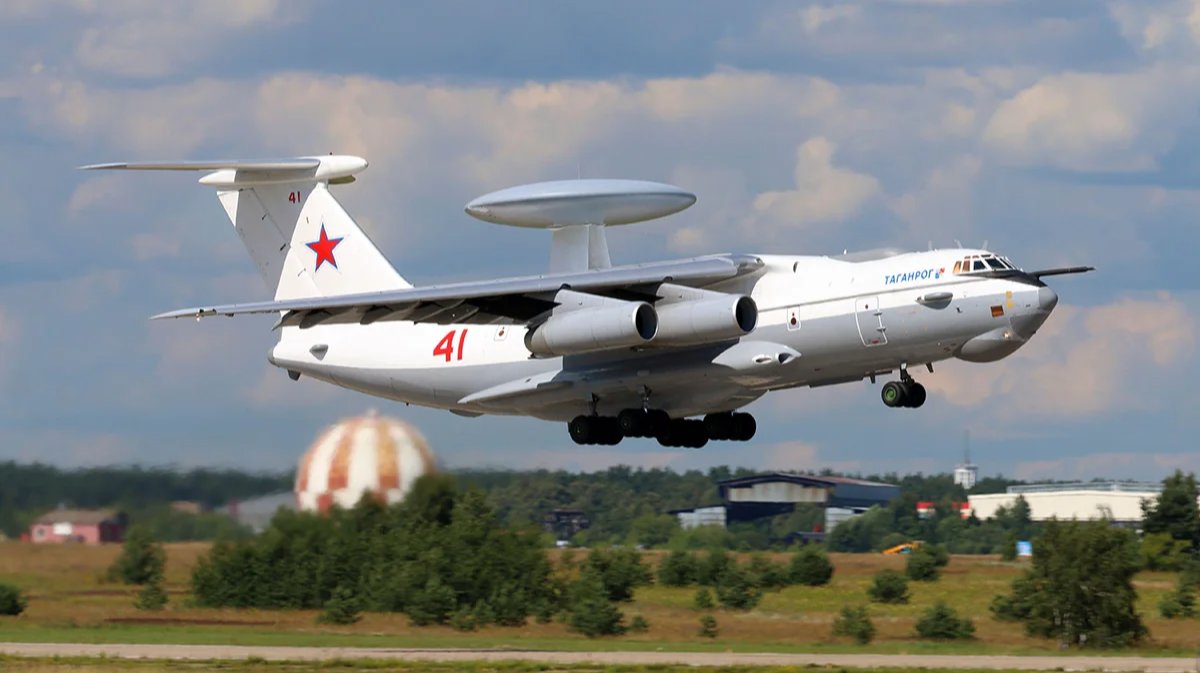Commander-in-Chief of the Ukrainian Armed Forces Valeriy Zaluzhnyi confirmed on Monday that Ukrainian missiles had hit two Russian command aircraft, an A-50 spy plane and an Il-22M “control centre”, over the sea of Azov at 9pm on Sunday.
Beriev A-50s, which cost as much as $500 million, are equipped with advanced radar equipment that can monitor activity hundreds of kilometres away. These planes are currently in use by the Russian military both to locate Ukrainian air defence systems and to pinpoint targets for Russian fighter jets. Each A-50 can track up to 60 targets and 12 fighter jets simultaneously, a Russian military expert speaking on condition of anonymity told Novaya Europe.
According to weapons directory The Military Balance, in 2022, the Russian army had only nine A-50s in use. Each aircraft carries up to 15 specialists, including five pilots and 10 tactical crew who interpret radar returns. All on board the A-50 are believed to have died.
Israeli military expert David Sharp likened the loss of an A-50 to the loss of the Russian army’s “eyes and ears”.
Sharp said each A-50 was a “very important component of the Russian armed forces” and that the successful Ukrainian strike represented a “very heavy loss” for the Russian military, both in terms of the plane itself and its personnel.
The other affected plane, the Il-22M, is not quite in the same league as the A-50, but it is a serious loss nevertheless: the UK Ministry of Defence has estimated that Russia has a total of between 12 and 30 airborne command and control planes of this kind.
The Il-22M was reportedly not totally destroyed in Sunday’s attack, but did suffer serious damage, according to Ukrainian media reports. Ukraine’s RBC news outlet published an alleged audio intercept of the Il-22M pilot requesting permission to make an emergency landing at Anapa airport in southern Russia for which he “urgently” requested ambulance and fire crew.
Photos of an Il-22 landing at Anapa airport, on the Russian side of the Sea of Azov, on Sunday night show the plane’s tail visibly mangled.

The damaged Il-22 plane. Photo: Fighterbomber / Telegram
Both the Russian Defence Ministry and Kremlin spokesperson Dmitry Peskov declined to comment on the incident.
Some pro-Russian Telegram channels have suggested that the planes were accidentally hit by Russian missiles rather than Ukrainian ones. But both military analysts Novaya Europe spoke to doubted the “friendly fire” hypothesis, with the Russian expert pointing out that the A-50 does not resemble any Ukrainian plane, and had been flying on its normal route, so there’s no reason that Russian attackers would have mistaken it for a Ukrainian aircraft.
Still, experts are unclear how Ukrainian forces could have managed to shoot down the planes, since the Ukrainian army is not known to possess long-range air-to-air missiles. Sharp believes the most likely scenario was a long-range anti-aircraft missile being launched from the front line using an American Patriot air defence system.
The damage visible on the Il-22M was consistent with that explanation, Sharp said, adding that Ukrainian military analysts would have had to study the A-50’s flight pattern very carefully to catch it at the one moment when it was within range of the Patriot system: “From the front line to the Azov coast is approximately 160 kilometres, which is the maximum range for Patriot missiles,” Sharp said.
Sharp also suggested that the Ukrainian military might have restored a decommissioned Soviet S-200 air defence system, which has a greater firing range than the Patriot, adding that the Ukrainian army had modified these Soviet-era missiles to attack ground targets in the past.
Join us in rebuilding Novaya Gazeta Europe
The Russian government has banned independent media. We were forced to leave our country in order to keep doing our job, telling our readers about what is going on Russia, Ukraine and Europe.
We will continue fighting against warfare and dictatorship. We believe that freedom of speech is the most efficient antidote against tyranny. Support us financially to help us fight for peace and freedom.
By clicking the Support button, you agree to the processing of your personal data.
To cancel a regular donation, please write to [email protected]

